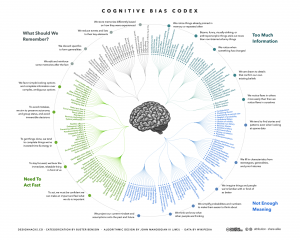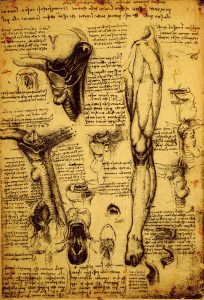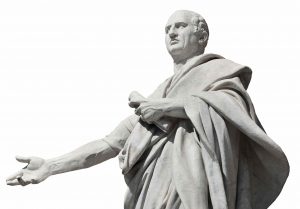Big Daddy/Big Data
Are older people wiser? If so, why?
Some societies believe strongly that older people are wiser than younger people. Before a family or community makes a big decision in such societies, they would be sure to consult their elders. The elders’ advice might not be the final word but it’s highly influential. Further, elders always have say in important matters. Nobody would think of not including them.
Why would elders be wiser than others? One theory suggests that older people have simply forgotten more than younger people. They tend to forget the cripcrap details and remember the big picture. They don’t sweat the small stuff. They can see the North Star, focus on it, and guide us toward it without being distracted. (Click here for more).
For similar reasons, you can often give better advice to friends than you can give to yourself. When you consider your friend’s challenges and issues, you see the forest. When you consider your own challenges and issues, you not only see the trees, you actually get tangled up in the underbrush. For both sets of advisors – elders and friends – seeing the bigger picture leads to better advice. The way you solve a problem depends on the way you frame it.
According to this theory, it’s the loss of data that makes older people wiser. Is that all there is to it? Not according to Seth Stephens-Davidowitz, the widely acclaimed master of big data and aggregated Google searches. Stephens-Davidowitz has written extensively on the value of big data in illuminating how we behave and what we believe. He notes that companies and government agencies are increasingly trawling big data sets to spot patterns and predict – and perhaps nudge – human behaviors.
What does big data have to do with the wisdom of the aged? Well … as Stephens-Davidowitz points, what’s an older person but a walking, talking big data set? Our senior citizens have more experiences, data, information, stories, anecdotes, old wives’ tales, quotes, and fables than anybody else. And – perhaps because they’ve forgotten the cripcrap detail – they can actually retrieve the important stuff. They provide a deep and useful data repository with a friendly, intuitive interface.
As many of my readers know, my wife and I recently became grandparents. One of the pleasures of grandparenting is choosing the name you’d like to be known by. I had thought of asking our grandson to call me Big Daddy. But I think I’ve just come up with a better name. I think I’ll ask him to call me Big Data.
Seth Stephens-Davidowitz is probably best know for writing the book, Everybody Lies: Big Data, New Data, and What The Internet Can Tell Us About Who We Really Are. He’s also a regular contributor to the Op-Ed pages of the New York Times. I heard his idea about seniors-as-big-data on an episode of the podcast Hidden Brain. (Click here). I mentioned his work a few years ago in an article on baseball and brand loyalty. (Click here). He’s well worth a read.
What We Don’t Know and Don’t See
It’s hard to think critically when you don’t know what you’re missing. As we think about improving our thinking, we need to account for two things that are so subtle that we don’t fully recognize them:
- Assumptions – we make so many assumptions about the world around us that we can’t possibly keep track of them all. We make assumptions about the way the world works, about who we are and how we fit, and about the right way to do things (the way we’ve always done them). A key tenet of critical thinking is that we should question our own thinking. But it’s hard to question our assumptions if we don’t even realize that we’re making assumptions.
- Sensory filters – our eye is bombarded with millions of images each second. But our brain can only process roughly a dozen images per second. We filter out everything else. We filter out enormous amounts of visual data, but we also filter information that comes through our other senses – sounds, smells, etc. In other words, we’re not getting a complete picture. How can we think critically when we don’t know what we’re not seeing? Additionally, my picture of reality differs from your picture of reality (or anyone else’s for that matter). How can we communicate effectively when we don’t have the same pictures in our heads?
Because of assumptions and filters, we often talk past each other. The world is a confusing place and becomes even more confusing when our perception of what’s “out there” is unique. How can we overcome these effects? We need to consider two sets of questions:
- How can we identify the assumptions were making? – I find that the best method is to compare notes with other people, especially people who differ from me in some way. Perhaps they work in a different industry or come from a different country or belong to a different political party. As we discuss what we perceive, we can start to see our own assumptions. Additionally we can think about our assumptions that have changed over time. Why did we used to assume X but now assume Y? How did we arrive at X in the first place? What’s changed to move us toward Y? Did external reality change or did we change?
- How can we identify what we’re not seeing (or hearing, etc.)? – This is a hard problem to solve. We’ve learned to filter information over our entire lifetimes. We don’t know what we don’t see. Here are two suggestions:
- Make the effort to see something new – let’s say that you drive the same route to work every day. Tomorrow, when you drive the route, make an effort to see something that you’ve never seen before. What is it? Why do you think you missed it before? Does the thing you missed belong to a category? Are you missing the entire category? Here’s an example: I tend not to see houseplants. My wife tends not to see classic cars. Go figure.
- View a scene with a friend or loved one. Write down what you see. Ask the other person to do the same. What are the differences? Why do they exist?
The more we study assumptions and filters, the more attuned we become to their prevalence. When we make a decision, we’ll remember to inquire abut ourselves before we inquire about the world around us. That will lead us to better decisions.
How Many Cognitive Biases Are There?
In my critical thinking class, we begin by studying 17 cognitive biases that are drawn from Peter Facione’s excellent textbook, Think Critically. (I’ve also summarized these here, here, here, and here). I like the way Facione organizes and describes the major biases. His work is very teachable. And 17 is a manageable number of biases to teach and discuss.
While the 17 biases provide a good introduction to the topic, there are more biases that we need to be aware of. For instance, there’s the survivorship bias. Then there’s swimmer’s body fallacy. And the Ikea effect. And the self-herding bias. And don’t forget the fallacy fallacy. How many biases are there in total? Well, it depends on who’s counting and how many hairs we’d like to split. One author says there are 25. Another suggests that there are 53. Whatever the precise number, there are enough cognitive biases that leading consulting firms like McKinsey now have “debiasing” practices to help their clients make better decisions.
The ultimate list of cognitive biases probably comes from Wikipedia, which identifies 104 biases. (Click here and here). Frankly, I think Wikipedia is splitting hairs. But I do like the way Wikipedia organizes the various biases into four major categories. The categorization helps us think about how biases arise and, therefore, how we might overcome them. The four categories are:
1) Biases that arise from too much information – examples include: We notice things already primed in memory. We notice (and remember) vivid or bizarre events. We notice (and attend to) details that confirm our beliefs.
2) Not enough meaning – examples include: We fill in blanks from stereotypes and prior experience. We conclude that things that we’re familiar with are better in some regard than things we’re not familiar with. We calculate risk based on what we remember (and we remember vivid or bizarre events).
3) How we remember – examples include: We reduce events (and memories of events) to the key elements. We edit memories after the fact. We conflate memories that happened at similar times even though in different places or that happened in the same place even though at different times, … or with the same people, etc.
4) The need to act fast – examples include: We favor simple options with more complete information over more complex options with less complete information. Inertia – if we’ve started something, we continue to pursue it rather than changing to a different option.
It’s hard to keep 17 things in mind, much less 104. But we can keep four things in mind. I find that these four categories are useful because, as I make decisions, I can ask myself simple questions, like: “Hmmm, am I suffering from too much information or not enough meaning?” I can remember these categories and carry them with me. The result is often a better decision.
Veni, Vidi, Da Vinci
What made Leonardo da Vinci a genius? I’ve just finished Walter Isaacson’s all-purpose biography of the Italian Renaissance man and four words come to mind: curiosity, observation, analogy, and humility. These four traits combined and recombined throughout Leonardo’s life to create advances in painting, engineering, architecture, anatomy, hydrology, optics, weaponry, and theater.
Leonardo maintained a childlike curiosity throughout his life. Every kid wants to know why the sky is blue. As we reach adulthood, most of us simply accept the fact that the sky is indeed blue. Not Leonardo. He studied the question for much of his adult life and ultimately developed an explanation based on clear evidence and careful reasoning.
Leonardo combined his curiosity with powers of observation that beggar belief. He noticed, for instance, that dragonflies have four wings, two forward and two aft. He wondered how they worked. By close observation, he concluded that when the two forward wings go up, the two aft wings go down. It seems like a simple observation but it must have taken hours of acute and disciplined observation.
Similarly, he took an interest in how birds flap their wings. Do their wings move faster as they flap upward or downward? Most of us would not conceive of such a question, much less focus our attention sufficiently to answer it. But Leonardo did, not once but several times.
His first observations – taken over many hours and days – suggested that birds flap their wings faster on the down stroke. At this point, I would have recorded my observation, concluded that all birds behaved similarly, and moved on. But Leonardo persisted. He observed different bird species and found that some flap faster on the up stroke than the down stroke. Wing behavior differs by species. It’s an interesting observation about birds. It’s a fascinating observation about Leonardo. Arthur Bloch once said that, “A conclusion is the place where you get tired of thinking.” Leonardo, apparently, never got tired of thinking. He recognized that all conclusions are tentative.
Leonardo didn’t just study insects and birds. He studied pretty much everything – from rivers to trees to pumps to blood circulation to optical effects to anatomy to geometry to Latin to … well, whatever caught his eye. His breadth of knowledge allowed him to draw analogies that others would have missed. Some of his analogies seem “obvious” to us today – like the analogy between water flow in rivers and blood flow in humans.
But how about the analogy between arteriosclerosis and oranges? As he dissected cadavers, Leonardo noticed that older people’s arteries were often less flexible and more clogged that those of younger people. He became the first person in history to accurately describe arteriosclerosis. He did so by comparing it to the rind of an orange that dries, stiffens, and thickens as it ages.
In today’s world, expertise is often associated with narrowness. Experts gain ever more knowledge about ever-narrower subjects. Leonardo was certainly an expert in several narrow domains. But he also saw across domains and could think outside the frame. Philip Tetlock, an authority on political judgment, suggests that this ability to think across boundaries is a key ingredient to insight and discovery. In many ways, Leonardo thought more like a fox and less like a hedgehog.
If I could think and observe like Leonardo, I might become a bit of a prima donna. But Leonardo never did. He remained humble and diffident in an ever-changing world. As Isaacson notes, he “… relished a world in flux.” Further, “When he came up with an idea, he devised an experiment to test it. And when his experience showed that a theory was flawed … he abandoned his theory and sought a new one.” By revising and updating his own conclusions, Leonardo helped establish a world in which observation and experience trump dogma and received wisdom.
Leonardo’s legacy is so broad and so varied that it’s difficult to encapsulate succinctly. But Isaacson includes a quote the German philosopher, Schopenhauer, that helps us understand his impact: “Talent hits a target that no one else can hit. Genius hits a target that no one else can see.”
Inventing Your Argument
Aristotle defined rhetoric as the ability to “see the available means of persuasion”. In other words, what will it take to persuade the audience to agree with your proposal? It may be an eloquent speech. It may be a brief video. It may be a nice bouquet of flowers. We aim to understand the dynamics of the situation and select the best available means of gaining agreement. To find the best persuasive approach, Cicero said that we need to consider five principles: Invention, Arrangement, Style, Memory, and Delivery. (Click here for brief definitions of each).
Many books on rhetoric present Cicero’s five canons rather formally. They may seem forbidding and perhaps somewhat outdated. But the canons are actually quite useful in finding the best available means of persuasion. To understand the canons and use them effectively, it helps to think of the questions each canon raises.
Let’s begin with the first canon: invention. We seek to invent the most persuasive argument for a given audience. Here are the questions to consider.
- What do you want the audience to do? This surprisingly simple question often goes unanswered. We may express our opinions without a specific goal in mind. As the Cheshire cat said, “If you don’t know where you’re going, any road will lead you there.” Your goal may be to convince the audience to vote for a given candidate or buy a certain product. The more specific the goal, the more persuasive the presentation. (Some inexperienced presenters seem to have a goal of showing the audience how smart they are. That’s usually not persuasive.)
- Are you a credible witness? Why would the audience trust you? If you have relevant experience, make sure the audience knows about it. You can state this yourself or ask someone to introduce you. (They can brag about your accomplishments better than you can). If you don’t have relevant experience, the audience may find you untrustworthy. In this case, you’ll need to enhance your credibility by citing people and sources that your audience respects.
- What are the benefits? To whom do they accrue? – Benefits may fall in several different categories. What are the benefits to individuals in the audience? What are the benefits to their families? To their companies? Think of the hierarchy of benefits and identify the most important ones. Make sure they’re highlighted throughout the presentation.
- Who will make the decision? What are their interests? – Emphasize the benefits to those who are making the decision. Early in my career, I sold word processing equipment that provided many benefits to clerical workers. But clerical workers didn’t make the buying decision. Financial managers did. I needed to state benefits for managers rather than for secretaries.
- How does the audience feel about the competition? – If the audience respects and admires the competition, it’s foolish to launch nasty zingers against them. Doing so simply diminishes your credibility. Clearly state your admiration for the competition, then identify how your solution is different and what benefits that produces.
- How can you convince the audience that you’re one of them? – You want your audience to think you are like them in some regard. This could be your experience, you manner of speaking, your vocabulary, your age, or even how you’re dressed. Don’t ever give the impression that you’re speaking down to your audience. Tip: you don’t need to dress like the audience; they may sense that you’re inauthentic. You do need to dress like the audience expects you to dress.
- What are the audience’s commonplaces? How can you frame your argument to fit their commonplaces? – A commonplace, in this sense, is a set of commonly held beliefs. A conservative audience’s commonplace might be: “We should take steps to enhance liberty.” A liberal audience’s commonplace might be “We should take steps to enhance justice.” You should always know your audience’s commonplaces and – to the extent possible – adapt your argument to fit them.
- What stories can you tell? – Audiences react much better to stories than to abstract concepts. Stories are memorable and touch on emotions. They illustrate ideas simply and clearly. Personal stories are the best but, if you don’t have a personal story to share, feel free to make up a story that illustrates your key points.
Remember that you’re just trying to invent the argument at this point. There are many more questions to ask round out a persuasive argument. If you can answer these questions, however, you can greatly enhance your chances of success.




